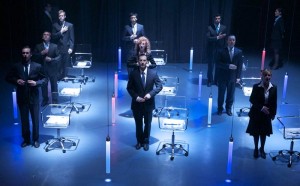Thanks to the lovely people at Masterclass, I had the opportunity to see ENRON at the Noel Coward Theatre this afternoon. Masterclass are a charity operated out of the Theatre Royal Haymarket, that provide young people with theatre arts experiences (workshops, seminars etc), so that they can get on in theatre themselves: from acting to directing to writing to producing.
I can barely remember the last time I set foot inside a West End theatre, and especially to see a drama so I wasn’t sure what to expect, despite the rave reviews the show has had.
I wasn’t disappointed.
The first thing to catch my eye (being of a techie persuasion) was the 12 pendant light fittings hanging at floor level as the preset. These are presumably LED as they change colour throughout the show as they fly in and out. These move relatively independently, with the downstage-centre 6 being often at a different height to those at the perimeter and are used brilliantly and simply to denote the change of location as we move into the low/red of the Finance Department and the floor-level/white spaciousness of Skilling’s office. This synergy between the set (Anthony Ward) and lighting (Mark Henderson) continues throughout the show and is something that makes the show feel very different and very watchable.
The show also makes use of projection (Jon Driscoll). This is normally one of my pet hates to within a show (especially with the student shows I have become accustomed to), because it is notoriously hard to make work – both physically and artistically. I think the reasons it works here are two-fold: as the show is quasi-historical, it can show archive footage, which really adds to the context of the plot and also the director (Rupert Goold)has not been afraid to shadow the screen. Realistically, casting a shadow on a front-projection screen is always going to happen and unintentionally it can look terrible as it diverts attention to the shadow, but by doing it with intent, the distraction is lost and here (at least) it works perfectly.
The dance and physical theatre aspect wasn’t something I particularly expected but, together with the comic turns (such as the Lehman Brothers), give the audience a sometimes needed break from the dialogue. This is not to say that the show is wordy or too complicated, but (as someone not that familiar with the backstory – I was barely a teenager…) the show did require some thought and I think I would have been exhausted by the end was it not broken up the way it is.
In fact, this is a strength of both the writing (Lucy Prebble) and directing to tackle some fairly abstract concepts, explain them, and then anticipate where the humour should be to keep us all engaged. The only place I started to get lost was in trying to understand the ‘raptor’ metaphor used to illustrate (I think) the ever increasing debt that the executives become slaves to, but the finer details were lost on me.
As usual, I will devote the least space to the aspect that most reviews would give the majority – the performers. The large (for a drama) chorus is a nice touch and allowed for a good amount of ‘hustle and bustle’ in the busy office scenes as well as delivering the physical set pieces. The principals came across as entirely believable, although as I didn’t have any idea prior knowledge as to how they should behave, I suppose that isn’t surprising. Having said that, the whole show did exude a sense of power which I can’t quite put my finger on, but it was certainly an atmosphere that worked. I slightly question the portrayal of Andrew Fastow (Paul Chahidi) as after he pathetically climbs his way to the top, you are left feeling almost sorry for him when it all comes crashing down at the end, which I didn’t feel was in keeping with the rest of the narrative.
Slight squabbles aside, this was a fantastic piece of theatre and if this is flying the flag for modern British theatre then I’m excited!

